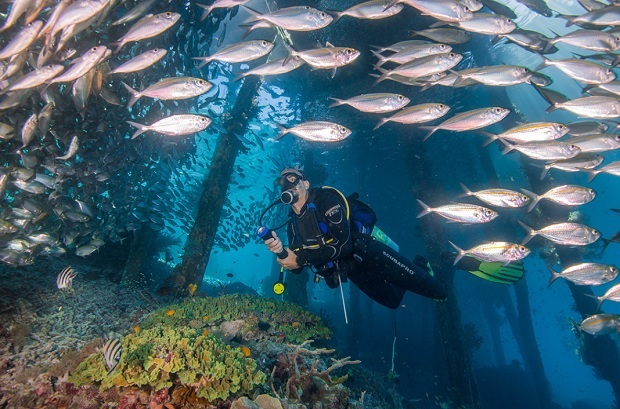Unveiling Underwater Treasures: Top Dive Sites in Indonesia

Indonesia, with its vast expanse of islands and pristine waters, is a diver’s paradise. Home to the heart of the Coral Triangle, this archipelago offers some of the most biodiverse and awe-inspiring dive sites in the world. Whether you seek vibrant coral reefs, thrilling encounters with large marine species, or captivating muck diving experiences, Indonesia has it all. In this article, we embark on an exploration of Indonesia’s top dive sites, where divers can immerse themselves in a kaleidoscope of marine life and create lasting memories beneath the waves.
Raja Ampat, West Papua
Regarded as the crown jewel of Indonesia’s dive destinations, Raja Ampat is an unparalleled underwater wonderland. With over 1,500 species of fish and 550 species of coral, this remote region boasts unrivaled biodiversity. Dive into the crystal-clear waters and be mesmerized by the kaleidoscope of colors as you encounter schools of fish, manta rays, sharks, and the elusive wobbegong shark. Don’t miss the chance to explore Raja Ampat’s stunningly diverse dive sites, including Misool Island, Mansuar Island, and the famous dive site of Cape Kri.
Komodo National Park, East Nusa Tenggara
Komodo National Park is renowned for its prehistoric inhabitants—the Komodo dragons—but its underwater realm is equally captivating. The marine life here is diverse and dynamic, with strong currents providing nutrient-rich waters. Drift along the thriving reefs, home to colorful soft corals, turtles, mantas, and sharks. Batu Bolong and Castle Rock are two iconic dive sites that offer exhilarating dives surrounded by schools of fish and pelagic species.
Bunaken Marine Park, North Sulawesi
For divers seeking a glimpse into the marine biodiversity of Indonesia, Bunaken Marine Park is an ideal destination. Situated in the heart of the Coral Triangle, Bunaken’s walls drop dramatically into the deep blue, offering encounters with reef sharks, eagle rays, and barracudas. The park is also known for its impressive coral formations and diverse marine life, including various species of nudibranchs and pygmy seahorses.
Wakatobi, Southeast Sulawesi
Wakatobi is a remote and pristine destination known for its exceptional coral reefs and vibrant marine life. The underwater seascapes at sites like the House Reef and the Coral Garden are a photographer’s dream, offering opportunities to capture the beauty of intricate coral formations and a myriad of reef fish species. As a testament to its conservation efforts, Wakatobi is teeming with marine diversity, making every dive an extraordinary experience.
Lembeh Strait, North Sulawesi
Lembeh Strait is a mecca for muck diving enthusiasts. Beneath the seemingly unremarkable sandy seabed lies a paradise for macro photographers and critter seekers. This area is home to some of the most bizarre and fascinating marine creatures, including mimic octopuses, flamboyant cuttlefish, hairy frogfish, and an array of nudibranchs. Divers can delight in the thrill of discovering the smallest and most peculiar critters hiding in the black sands.
When to go diving in Indonesia
The best time to go diving in Indonesia depends on the specific location. In general, the dry season (April to October) is the best time to dive in Raja Ampat and Komodo National Park. The wet season (November to March) can be good for diving in Lembeh Strait and Bunaken Marine Park, as the water is clearer during this time.
What to bring
When packing for a diving trip to Indonesia, be sure to bring the following:
- A valid scuba diving certification
- A wetsuit
- Buoyancy compensator (BCD)
- Regulator
- Dive computer
- Mask, fins, and snorkel
- Scuba diving logbook
- Sunscreen
- Insect repellent
- First-aid kit
Where to stay
There are many great places to stay in Indonesia, from budget-friendly hostels to luxurious resorts. If you are planning on diving, be sure to choose a place that is close to good dive sites.
How to get there
The best way to get to Indonesia is to fly. There are many international airports in Indonesia, including Jakarta, Bali, and Manado. Once you arrive in Indonesia, you can travel to the different dive sites by plane, boat, or car.